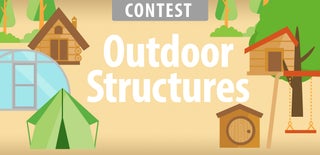Introduction: Build a Langstroth Bee Hive (beekeeping the Simple Way)
This is a simple made Langstroth bee hive. You can use any wood you like. I find some of the parts i used in the trash. Make sure its mass wood and burn it with a flamepistol to kill any fungus or microbes before using it to build the hive.
I used 28mm screws and woodglue to assembly the parts. I include a 3d Rhino file with all the parts i cutted. I adjusted the dimensions according to the breadth of the frames available in the local market (Tirol). If your frames have different breadth, adjust the hive plans keeping in mind the the bees need internaly ~8mm space between the frames and the surrounding surfaces (interior walls, top cover, top or bottom frames, etc).
Attachments
Step 1: Bottom Board Α - Open Mesh Floor for the Varroa Mite Control
The Bottom board is open and a mesh with ~3mm holes is attached so as to control the Varroa mite. The mites are falling from the bees while they clean each other. Under the metal mesh there will be hanging a plastic tray that will collect the mites. The tray will be sitting on six screws, providing the less possible space that would act as a 'bridge' between the tray and the rest of the hive, therefore preventing the mites from climbing back, up on the hive.
Step 2: Bottom Board Β - Entrance
The opening to the back helps with cleaning the metal mesh without disturbing the rest of the floors
There is one front entrance for the winter (short) and one for the summer. The openings prevent bigger insects to enter the hive.
Step 3: Deep Super
Step 4: Shallow Super
Step 5: Inner Cover - Feeder
The board is 5mm MDF. There will be cutted a round hole in the middle so the bees can access the feeder
Step 6: Outer Cover
The black board of the top cover will be covered with corrugated metal
The wood stripes on the third picture, are placed there when there is no feeder inside, to help the ventilation of the top space. The inclination of the top help also the rain water to run quicker away from the hive
Step 7: The Traditional Plans
Here are some pdf i used before start building
any suggestions from the experienced beekeepers about upgrades for my hive, will be welcome!
Special THANKS to Claudia for providing as the space to work and place the hives :)
Christos and Carmen
Attachments
 @ Bauplan-Zander-Einfachbeute.pdf
@ Bauplan-Zander-Einfachbeute.pdf 4. ΤΕΧΝΙΚΑ ΧΑΡΑΚΤΗΡΙΣΤΙΚΑ ΚΥΨΕΛΗΣ - ΔΙΑΣΤΑΣΕΙΣ.pdf
4. ΤΕΧΝΙΚΑ ΧΑΡΑΚΤΗΡΙΣΤΙΚΑ ΚΥΨΕΛΗΣ - ΔΙΑΣΤΑΣΕΙΣ.pdf ΚΑΤΑΣΚΕΥΗ ΚΟΥΤΙ ΔΙΑΣΤΑΣΕΙΣ.pdf
ΚΑΤΑΣΚΕΥΗ ΚΟΥΤΙ ΔΙΑΣΤΑΣΕΙΣ.pdf

Participated in the
Outside Contest 2016

Participated in the
Outdoor Structures Contest

Participated in the
Beyond the Comfort Zone Contest















